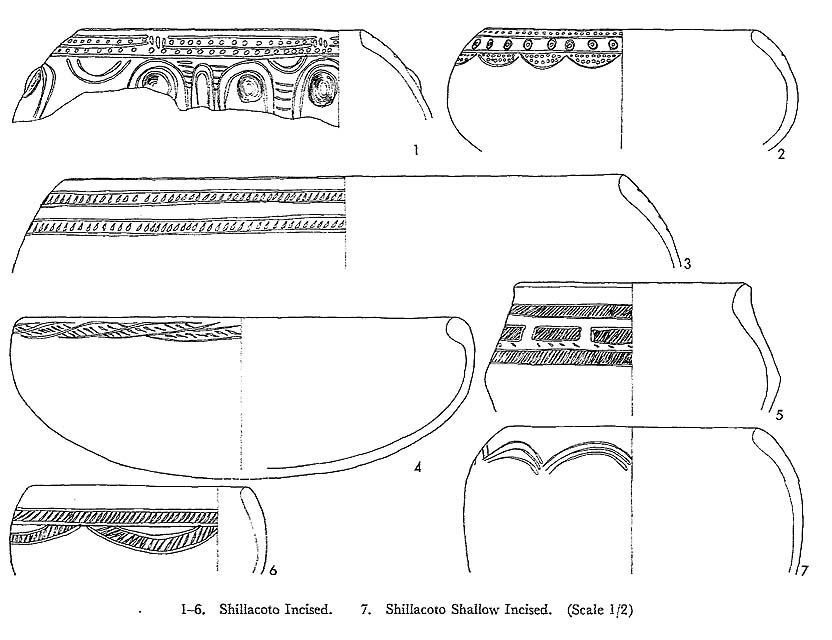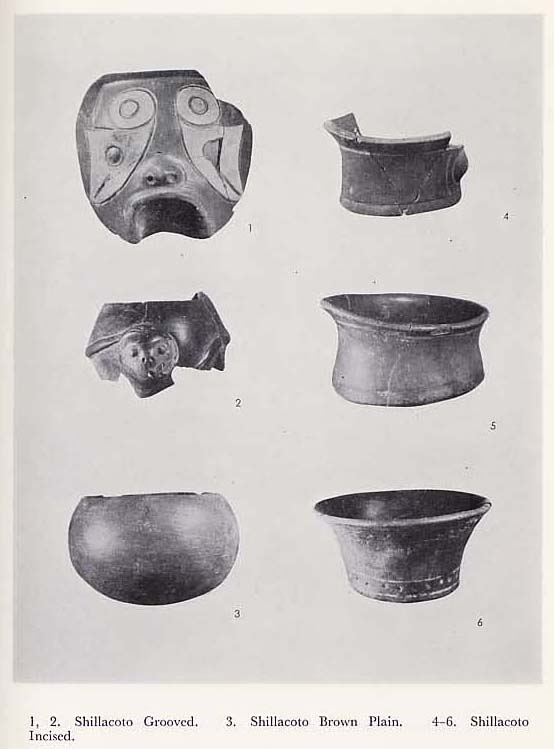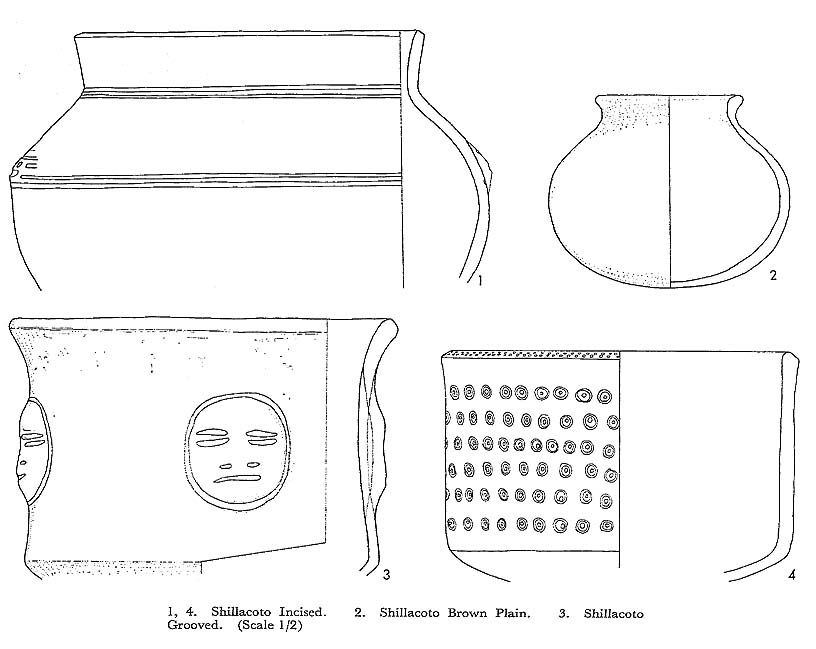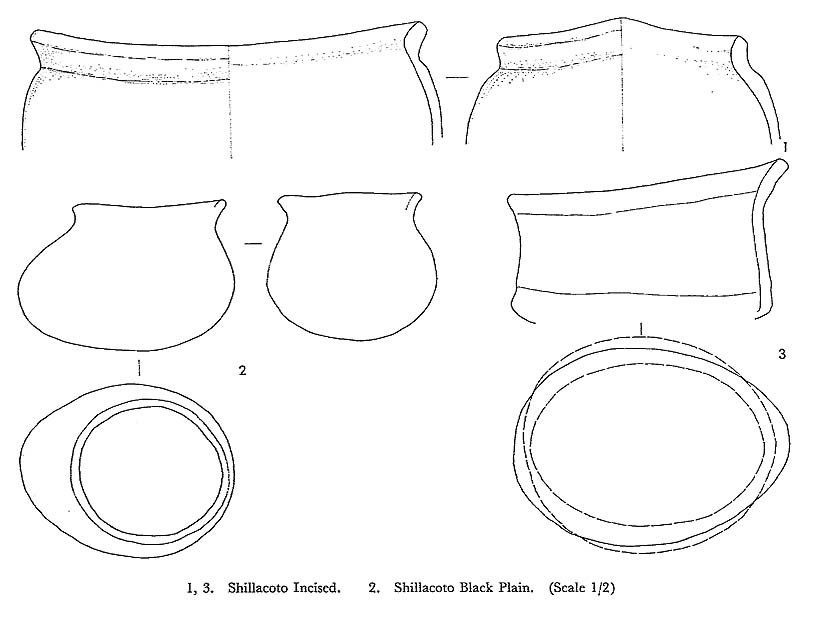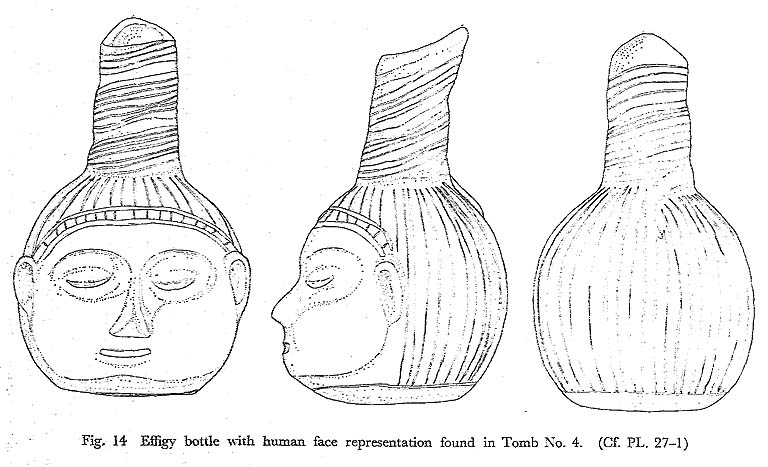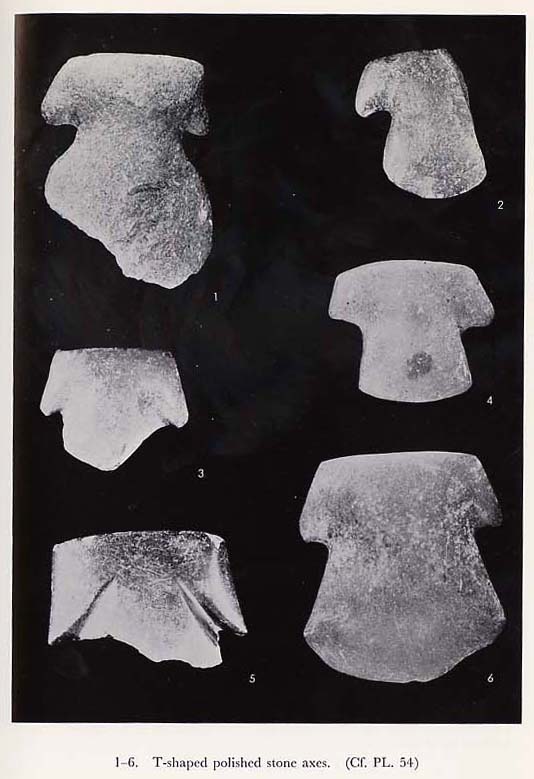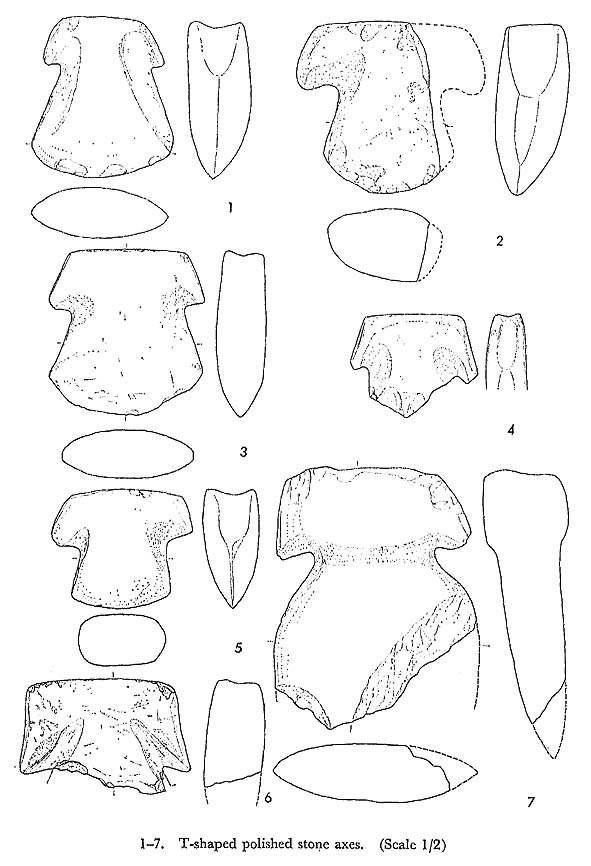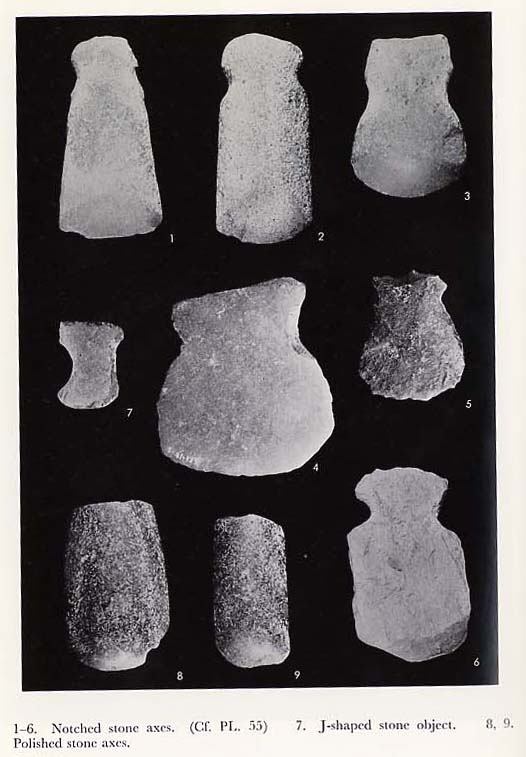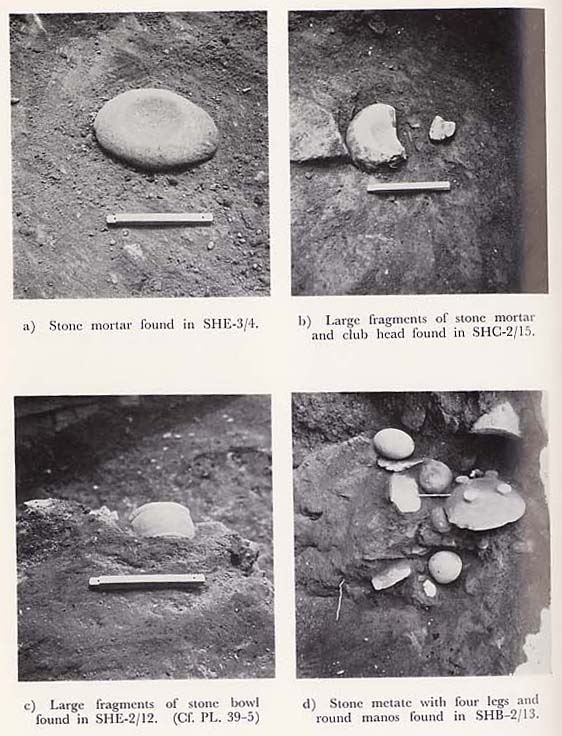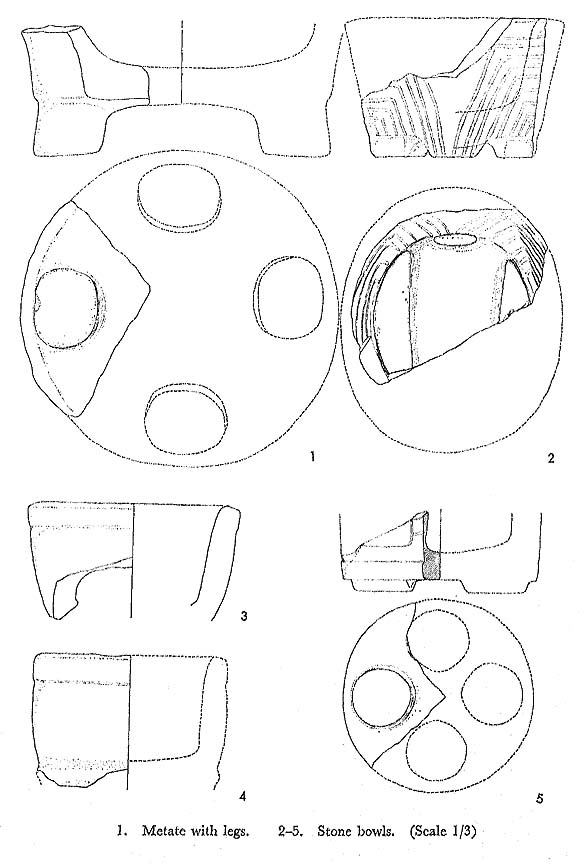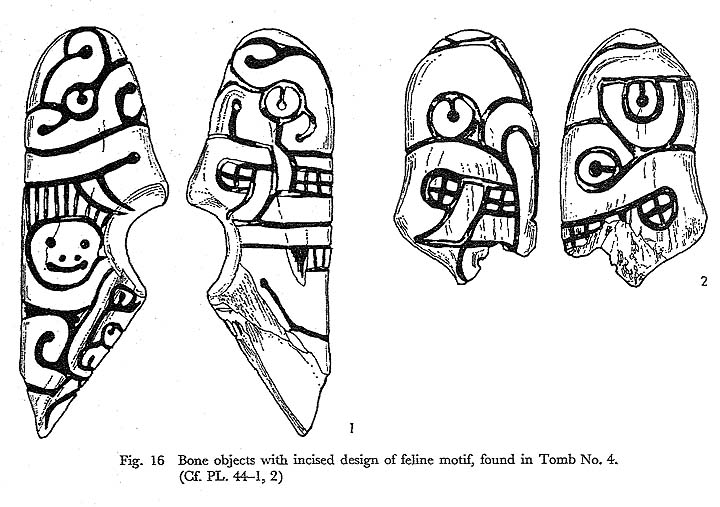CHAPTER III ARCHAEOLOGICAL REMAINS
|
As was mentioned in the Introduction, all the archaeological remains discovered at Shillacoto arc being preserved at Huanuco University, Peru. The arrangement of these materials is still in progress and unfortunately was not ready for the pub-lication of this excavatory report. Therefore, only those artifacts which were thought to be especially important were selected and the explanatory descriptions which follow are limited to those which were made through the use of photo-graphs and survey diagrams. POTTERYAt Shillacoto, the overwhelming majority of the earthenwares were from the pre-Chavin periods of Shillacoto-Kotosh, and Shillacoto-Wairajirca. From the point of view of type and style, the basic characteristics of most of them were con-sistent with the pre-Chavin period pottery found at Kotosh. However in terms of shapes and patterns, the Shillacoto pottery showed much more variety and there were more types present. Also, some types were discovered for the first time at Shillacoto. However, it must be stated here that the method of classification and designation reference is based on the Kotosh Report (Izumi and Sono, 1963) produced earlier and it has been used temporarily for converenience sake. Shillacoto Higueras RedThe pottery of the Shillacoto Higueras Period corresponds closely to Kotosh Higueras Red, and since there are no noteworthy features to mention as com-pared with Kotosh, a description of this type of pottery has been omitted. This subject will examined in detail in the future. Shillacoto GroovedThis type of pottery belongs to the Shillacoto-Kotosh Period and is formally equivalent to Kotosh Grooved (Izumi and Sono, 1963, pp. 116-118). The surface colors range from black to brownish red. Both the exterior and interior of this pottery are well polished and smooth. Form: The main forms were bowl, jar and bottle and amongst these there was a large number of bowls of various shapes, e.g. deep, wide-mouthed carinated bowl. The other bowls include deep bowl with sides slanting slightly outward to the rim, bowl with gently outward-sloping sides and almost flat bottom (PL. 48-5), deep bowl with triangular mouth, deep outward-flaring bowl with a ridge at the waist (PL. 50-1), large carinated bowl with convex sides, deep bowl with lateral flange just below the rim, shallow bowl with slightly thickened rim, shallow bowl with slightly convex sides.
Jars and bottles include globular neckless jar, globular jar with short flaring neck, double shouldered globular jar, flaring neck, long-necked bottles with globular body, and also long-necked bottles with angular shoulder and base. Decoration: Geometric patterns are very common, especially square, diamond and triangular shapes marked with grooved incision or broad line some of which had punctation inside; such designs were extremely popular, and the patterns fitted into one general type (PLs. 47-1, 3—5, 48-2—4). The main design motifs apart from these were the scale motif (PL. 48-5), row of triangles, row of semi-circules, cloud shape, circle-and-dot, step design and plant motif.
In special cases, the decoration of the pottery had stylized human faces or anthropomorphic monkey design. Most of the faces were made by punching from the inside and on this round-shaped protuberance the outline of the face or other features were described by incision or punctation (PLs. 31-1—2, 52-3). Also the shapes of other animals appeared (PLs. 28-2, 29-2). However, the examples in Plates 31, 1—2 belong to the Wairajirca Period and we think that this type of pottery needs to be classified in more detail at some future date. Amongst the patterns listed above, the method of post-fired painting with graphite paint or filling the incised lines with three colors of paint; red, yellow and white,was very common. Especially noteworthy ceramic artifacts which were newly discovered at Shillacoto are as follows.
Long nekced effigy bottle with representation of human face (PL. 27-1, Fig.14). This was discovered in Tomb No. 4 of the Kotosh Period ; the face portion was colored reddish-purple, and the rest was entirely light-brown in color. The representation of the face was so realistic that we could not help thinking that it was a portrait of the person buried in that tomb. The eyebrows, nose and ears. were shaped by modelling techniques while the eyes and mouth were incised. On the top of the forehead was placed a headband decoration and this was de scribed by two parallel incised broad lines with short vertical lines in between, and the hair was described by narrower incised lines, its style was gathered on top twisted up in a clockwise fashion (from right to left) and the end of the hair hang down for a short distance on the back of the head. Thus the spout was shaped just like a chignon. We believe that either this hairstyle was very popular among the people of those times or that it was peculiar to the person buried in this grave. Whichever is true, this piece of pottery is extremely realistic and if it is in fact the portrait of a person who actually lived then, we can deduce that the people of the pre-Chavin period in this area were without doubt of Asian race on account of the facial features and also we can definitely learn something of the customs, such as hairstyle, of this period, all of which make this an extremely important material find. In all probability, this piece of material is not only important from an archaeological point of view but also for ethnology and folklore. Actually the custom of making a portrayal of a person's face and burying it along with the dead was extremely popular in the later Mochica Period and this pot might indicate the origin of this custom. Also discovered in Tomb No. 4 was another piece of pottery which represented a child's face (PL. 28-1). It is of reddish-brown earthenware and it shows a child with its mouth wide open as if crying or shouting, but this potsherd is not complete, only the mouthpiece was found and the body of the jar was missing. This potsherd was very realistic in appearance and the features of the child's face were really well described. The ears and nose were created by modelling and the eyes by both modelling. and grooved incision.
Long necked bottle with stylized plant design (PLs. 27-2, 47-2). Once again this was discovered in Tomb No. 4. The neck is wide and strong, the rim is. slightly everted, the juncture of the body with the base is angular, the base is rounded, the surface color is entirely light grey and appears to be graphite painting but this question will examined in more detail in the future. There are two parts with patterns, the shoulder and the body, and there are different patterns. on each. In other words, on the shoulder there were two broad incised upper and lower horizontal lines and in between there is a geometric pattern drawn in broad line incision and on the body, there are also two parallel upper and lower lines in between which there are several vertical partition lines which divide the area up into small square panels, and inside the panels a stylized plant design had been drawn. This pot was very hard and strongly made, the preparation of the surface was extremely fine and it has metallic texture. Discovery of such a magnificent pot completely intact is very rare and once again this is an extremely important piece of archaeological material. Deep bowl with representation of monkey faces (PL. 29-1). This was dis-covered in the 11th ash layer in E-2 zone, only the part of the monkey face was found, and the remainder was missing. Alternatively, this object could have originally been manufactured as a mask. This is a reddish-brown piece of pottery, the head is colored with graphite painting, the center of the eyes protrudes and the outline is deeply described by grooved incision, the nose and mouth are modelled, and from the forehead to the cheek, the design is boldly marked by deep grooved incision. The design is symmetrical and on either side of the forehead, alarge double circle pattern is drawn. Inside of the eyes and the grooved incisions were colored by graphite painting and the areas enclosed by the incisions were painted with yellow pigment. This is a very unique object and other examples of face design covering the entire surface of a pot were not to be found even here in Shillacoto. Shillacoto Black Polished IncisedThe frequency of occurence of this type of pottery at Kotosh was small (Izumi and Sono, 1963, p. 120) and no complete pots were found, so that it was difficult to define the characteristics accurately. On the other hand, the occurence at Shillacoto was much greater than at Kotosh and in addition, there were large numbers of complete or restorable pots and the shapes, patterns and types of pots were quite clearly defined. This type of pottery also includes Brown Polished Incised, the only difference between the two being one of surface color as the quality is almost the same and the paste is of fine clay tempered with fine grains of sand. The exterior is very well polished and has a luster. Form: The forms of pottery were mainly bowls and shortnecked bottles; the former being small bowl with slightly convex wall, bowl with vertical sides with nearly flat bases being the most common, and the latter were small jar with short flaring neck and a flat base-which has some features in common with the shoe-shaped vessel (PLs. 31-4,49-1) -, short necked globular jar with wide mouth (PLs. 30-1, 50-2), these two types having been identified thus far.
Decoration: Two distinct patterns were discernable, either simple geometric patterns in incision or fine line, or a combination of these geometric patterns with a decoration in the appearance of an animal. The geometric patterns usually took the appearance of sections described by horizontal and vertical incised lines with either short incised lines or punctation inside. However, there were some cases in which the entire body was filled by drawn patterns (PL. 30-1). Also the inside of the incised lines was post-fired painted with red, yellow and white pigments. The animals which appear most often in the designs were the cat (PL. 33-4), bird (PL. 31-3) and monkey (PL. 31-4) and in these cases, the ear, nose and beak were made by modelling, while the detailed features such as the outline of the face or the eyes and mouth were by incised line or fine line.
This pottery was unearthed from the Wairajirca and Kotosh Periods strata at Shillacoto, but proper classification and detailed analytic investigation has not yet been carried out. Shillacoto IncisedThe shape, pattern and other formal characteristics of this pottery once again corresponded to Kotosh Incised. However, as in the case of Shillacoto Grooved, the quantity was large and new types of motif and more complicated variations were found. In most cases, the paste was of good quality, the firing techniques were also good and this produced very fine quality pottery which was both thin, hard and compact. The colors varied between brown, dark-brown, black-brown and gray-brown. The pottery surface was well prepared although not polislied so strongly, but in a few cases it was extremely highly polished with a strong luster. Form: Bowls and jars were most common. Noteworthy types of bowls included bowls with convex, concave, vertical or straight sides, large bowl with rounded or angular shoulder and constricted mouth, deep bowl with lateral flange and ridges, carinated bowl with convex sides, deep bowl with triangular mouth, boat-shaped bowl and kidney-shaped bowl. Among the jars were neckless glob-ular jar, neckless globular jar with moderately thickened rim, rounded neckless jar with slightly angular shoulder, short flaring necked globular jar, round wide mouthed jar, etc. Decoration: Most noteworthy of the decoration techniques was the speciality of zoned hachure and in addition to this excision, broad line incision, deep broad line incision, fine line incision, punctation, impress, post-fired painting were used. By using these techniques and methods a wide variety of patterns were applied. Design motifs consisted of narrow hatched band (PL. 30-3), design composed of straight or curved lines and punctations (PL. 30-2), frets (PL, 30-4), steps (PL.30-6),row of triangles or semi-circles, cloud shapes, scrolls, circle-and-dot, circles and crosses. Combinations of these motifs were inscribed on the entire surface of the pots to create magnificent and harmonious geometric patterns. In addition to these, other patterns were observed which consisted of incised drawings of an owl (PL. 31-6), other birds, animals and plants. It was popular to make post-fired painting of the inside of the incised lines with red, white and yellow pigments. Especially of interest in this type of pottery discovered at Shillacoto, as it is represents a new material, was a pot with an anthropomorphic representation of a monkey (PL. 31-5). This pottery is hard with gray-brown color, the outer surface is well prepared to produce an exquisite high quality piece of earthenware. Two-thirds of the pot has been repaired revealing a triangular mouthed jar and the anthropomorphic design of a monkey face appears on two of the corners of this triangular shape. Except for this face, the whole of the body area is covered with punctation. The method of making the face was the same as that used in making the face in the pots preciously classified as Shillacoto Grooved (sec PL. 31-1—2). This type of pottery was produced continuously during the Kotosh Period, and when a comparative study is made of this type, firstly the number of monkeys is large and though the representation is anthropomorphic still the basic character of the monkey is emphasized but over a large number of examples a sequence is discemable in which the representation of the monkey face gradually changes into a human face, and finally we believe that this process of change gave birth to the beautiful vessel with five human faces which is typical of the Kotosh Period pottery discovered at Kotosh. In any case, the examples discovered at Shillacoto represent a prototype for this type of pottery and these materials are very important in order to understand the development and changes of this pottery in the future. Shillacoto Shallow IncisedThis type of pottery also corresponds to Kotosh Shallow Incised (Izumi and Sono, 1963, p. 121) and in Shillacoto, the most important point to mention is that this pottery was found on the lower floor or in the remains of the hearth of the temple of the Mito Period (PL. 32-3).
The surface color is generally black or dark-brown and the quality is poorer and thicker than Shillacoto Incised but among these gray-brown color and fine quality pottery were also found (PL. 32-1). Form: The main forms were deep bowl with bevelled rim and collared rim, small bowl with slightly convex or vertical wall and flat bottom, sometimes with vertical loop handle (PL. 32-2), long necked bottle with double shoulder (PL. 32, 1—2), neckless globular jar with thickened rim, and bottle with double spout and bridge, and according to a complete pot from the Jose Cuculiza Collection, which is said to have been unearthed at Shillacoto, the mouthpiece of such pots is wide and short, the bridge is semicircular and high, and the body is globular. Decoration: The method of decoration is mainly with shallow broad line incision and punctation. Geometric patterns consisting of small rectangular partitions arranged horizontally around the bowl or jar and sometimes in combination with a row of semi-circles were very common. On the handles, a design resembling a tadpole shape also appears. In the case of the long-necked double-shouldered bottle, the upper shoulder is covered with elongated triangular zones which are filled with short incisions, and the lower shoulder has a pattern of gadrooning on it. This type of pot and the bowl shaped pot with handle which was discovered on the lower floor of the Mito Period temple are both extremely rare materials. Shillacoto Monochrome PlainUnder the classification of Monochrome Plain, there are three types; Red Plain, Black Plain and Brown Plain. These types of pottery appeared from the Kotosh Period through the Wairajirca Period, they are all plain ware and are temporarily grouped together under the collective name of Monochrome Plain. Normally, there is a propensity for the Red Plain (PL. 27-4) and the Black Plain (PLs. 27-5, 28-4, 5) to be most numerous in the Kotosh Period stratum while the Brown Plain (PLs. 29-3, 32-4) are most common in the Wairajirca Period stratum. However in the future, these materials will be arranged and classified in more detail and we believe that more study is necessary. Form: Bowls and jars are the most common forms. Bowls include the globular or semi-globular bowl with slightly constricted rim and rounded base, the bowl with outward sloping sides and fit bottom, the shoe-shaped bowl, etc. Jars include the globular jar with slightly everted rim or with short flaring neck, round wide mouthed jar, neckless globular jar with thickened or nonthickened rims, etc. A large number of sherds from the neck part of long necked bottles were found but as none of these were complete we cannot ascertain if there was actually any design pattern on the waist or body, or not. Alien TypeThere were some fragments of pottery discovered which did not conform in terms of shape and style with the other pottery of Shillacoto proper which were mentioned above. (PLs. 43-9, 10, Fig. 15). Both of these were portions of the rim and both belonged to different pots. One (PL. 43-10) was brown in color and the inside was well smoothed, the paste is tempered with coarse grain sand and grey in color. We think that the original shape was that of a large jar with slightly flaring short neck and that this fragment corresponds to part of the neck. We cannot know the shape of the body of the pot, but the neck is covered entirely by a continuous design of frets described by sharp deep incision. The nonincised part has been scooped out with excision techniques giving the effect that the frets are in relief. The inside of the incised portion has been filled with white paint and the excised portion with yellow paint in post-fired painting.
The other example (PL. 43-9) is blackish-brown in color and once again the inside is well polished and smooth. The paste is of high quality clay mixed with comparatively fine sand. It is not certain if this comes from a bowl or ajar but the side wall is straight and has a wide flaring lip. The pattern was similar to the previous pot and consisted of frets but the excision in between was shallower. The method of filling the incision with white paint and the excision with yellow after firing is also the same. Although we can point out similarities between these pots an other pottery of Shillacoto or Kotosh, from many points of view, still these have not been normally found before in the Huallaga River basin. Rather they are said to correspond to the Early Shakimu type of the Ucayali River basin in the Sclva region (Donald Lathrap, personal communication). If this is true, these materials provide evidence of cultural exchange at a certain period between the Highlands and Selva regions. These potsherds were discovered at Shillacoto in the 11th and 12th layers which were also the same level at which Kotosh and Wairajirca Periods potsherds were mixed together. We intend to study more thoroughly the question of which period these pots belong to, at the same time as carrying out the arrangement of materials. THE LITHIC OBJECTSBasically there is not so much difference between the lithic objects found at the various archaeological sites in the Huallaga River basin just as was the case with the pottery. But the important aspect of the Shillacoto investigations was that whereas in previous excavations the stratigraphic or chronological definitions were unclear, at Shillacoto these points could be defined more accurately. And also some new types were added. Moreover the combination of the stone objects could be clarified. Especially at Shillacoto, a large number of lithic objects were found which belonged to the Kotosh and Wairajirca Periods and these were mixed together with a wide variety of potsherds, which will be useful in study and definition of the substance of life in the pre-Chavin culture in the Andes. The lithic objects discovered were as follows: polished stone axes, club heads, knives, :chipped stone axes, chipped and polished projectile points, stone vessels, metates, manos, pestles, spindle whorls, car-ring, pendants, stone figurines, jet mirrors and other objects of unknown use. The T-shaped Polished Stone Axes The stone materials used were diorite, basalt, porphyrite and so on. The special feature of this type of stone axe was that in order to attach the handle there were ear-shaped or T-shaped portions extending on either side of the axehead. The top part of the head had a groove cut in it to fix the handle in. The average length is about 8 cm. but on occasion those as large as 15-20 cm. are found (PL. 54-7). At Shillacoto, these were found continuously from the Wairajirca stratum to the Higueras stratum, but the largest number were unearthed from the Wairajirca stratum (PLs. 34-1—3, 35-3—6, 54-3—6). Usually, during the Wairjirca Period the cutting of the stone was angular, it was well polished and the cutting edge was sharp and the earlike extensions were comparatively big and strong. Axes, of the Kotosh Period (PLs. 35-1—2, 54-2, 7) did not change much compared with the previous period, but the sliape had lost a little of its sharp angularity, becoming slightly rounder and the polishing was less complete. In the Higueras Period, the size had become slightly smaller and the ear part had become narrower vertical relative to the whole length of the axe, approaching more nearly the shape of T. There was a trend for the groove in the top to become shallower and in fact sometimes there was no groove at all. We can infer from the evolution of the sliape that probably this refleets a change in the usage of the axe itself.
Chipped and Notched Stone Axes Only two chipped stone axes were discovered (PLs. 36-4—6, 55-3—4). One was discovered at the level of the lower floor in S-R7 (PLs. 36-6, 55-4) and its shape was made by crudely breaking a piece of micaschist. Both shoulder parts. were deeply notched and these portions were also polished a little. The cutting edge was produced by chipping away one side to make a blade but it was not sharp. The other axehead was unearthed from the floor of S-R7 (PLs. 36-4, 55-3) and this was produced by Chipping a pebble. Once again on either side-of the top part were notches, the cutting edge was made by chipping off from both sides. One side of the axe was the natural surface of the pebble while the other side was rough and had not been worked after the original breaking.
Polished and Notched Stone Axes These occurred during both the Kotosh and Wairajirca Periods but not during: the Higueras Period. There were two shapes; the first being long and thin shaped rather like a pole with shallow notches on both sides at the top, the cutting; edge had been sharpened from both sides and was very sharp (PLs, 36-1—2,55-1). However apart from the edge, the other parts of the axe were not well polished and a porous surface was left. The second type was oblong in shape (Pls. 36-3, 55-2, 5), the notches were from the top to the waist angled in widely and gently. The cutting edge was sharpened from both sides and was very sharp but the marks of pecking were still left at the notches. In the case of PL. 55-5, neither end was. sharp and it is indeed doubtful whether this tool was an axe. Polished Stone Axes These are ordinary shaped axes and all belong to the Wairajirca Period ; the surface is well polished and the cutting edge is sharp (PL. 36-8—9). Chipped Projectile Points Almost all are made of flint, the size is from about 4 to 10 cm. There are three different shapes; small leaf shape (PLs. 41-6—8, 58-6—8), medium size triangular or ovoid shape (PLs. 41-1—4, 9—10 and 58-1—5, 9) and large size ovoid shape (PLs. 41-11, 58-10). Both surfaces of the blade portion of all of these with the exception of the large size was finely and delicately retouched. Some of them have very sharp serrated edges and there were two examples from the Kotosh Period with stems and one from one Wairajirca Period with was slightly edged in one side of the base portion like the Sandia Point (PLs. 41-10, 58-5). All of the chipped projectile points were discovered in the Wairajirca and Kotosh strata and none came from the Higucras Period.
Polished Projectile Points Only four of this type of stone object were found. They are made of slate, all belong to the Higueras Period and as there are no marked differences between these and those found at Kotosh. Polished Stone Club Heads Materials used were sandstone, hornfels, porphyrite, microgabbru, granite and so on. They can be roughly divided into four types; spherical, oblong or circular, diamond shaped and star shaped. A large number of the spherical type were produced in the Wairajirca Period, they were polished all over and were carefuly and precisely made. The average diameter is about 10 cm., a hole had been drilled through the center from both sides, and the inside of the hole is well polished. In the Kotosh Period, the spherical shape began to give way to a large size oblong form with average diameter about 15 cm. and thickness about 5 cm. (PLs. 37-9, 56-4). The finish was not so well polished and the porous surface was left and the method of drilling the hole was a little crude. During this period also appeared a new shape. The center of each side began to become protruded giving a cross-section shaped like a diamond (PLs. 37-2, 56-1—2). The stone was sandstone and the production method was not so skillful. The circular type was very common in the Higueras Period, it was on the thin side, the average size being diamater about 7 to 8 cm. and thickness 2 to 2.5 cm. (PLs. 37-3—4, 56-5). The use of sandstone was very common. The diamond shape mentioned previously still existed in this period but its side became more sharply pointed (PLs. 37-1, 56-3). The star-shape first appeared during the Higueras Period ; actually the number of protuberances varied between 4 and 6, the type of material most commonly used was granite and there was a large variety of sizes between 8 cm. × 7 cm. to 12 cm. × 3 cm.
Polished Stone Knives The use of slate was very common, there are two main shapes which are rectangular (PLs.34-5—6, 38-1—4, 6 and 57-3—7) and semi-circular (PLs, 34-4, 38-5, and 57-1—2) respectively. The rectangular shape was present in large number in the Wairajirca Period layer, it was precisely made, the four corners being finely shaped and the surfaces were well polished. They covered a wide ranges of sizes with length from 13 to 15 cm., width from 7.5 to 9 cm., and thickness from 0.5 to 1.3 cm. One side of the knife was made into a blade and had both surfaces sharpened so that it was very sharp indeed. In all cases, the surfaces of the blade had parallel scratches which definitely show that these were used as tools for cutting. One of them had an incised cross hatched design on one side and on the other side in the center was a vertical line which appeared to have been made by rubbing (PLs. 38-6, 57-7). The semi-circular shapes were unearthed from the Kotosh Period layer and again it had a blade on one edge which was sharpened on both surfaces. However the production method was rather rough and in some cases the blade was made by simply chipping a pebble (PLs. 38-5, 57-1)
A very unusual object which belonged to the Wairajirca Period had one side made as a blade and the other was a saw-toothed edge and also the base had a stem (PLs. 34-7, 58-11). Stone Bowls, Metates and Manos A large number of stone bowls or mortars were unearthed. Of these the majority belonged to the Wairajirca stratum and the forms were bowls with slightly curved sides, outward sloping sides and straight; sides (PLs 39-5—9, 59-2—5). Patterns were either an incised line running parallel to the rim or the entire surface covered with incised geometric patterns. Both the inner and outer walls were well polished. The most interesting aspect is that the objects had 4 legs. The metate type varied in size from as large as 1 meter in length to about 20 cm. (PLs. 39-10, 60-3). The upper surface was either flat or concave. Also some were discovered which had 4 legs (PLs. 26-1, 39-11, 59-1). These objects were all much larger in size than ordinary bowls and in addition the inside upper surface had scratch marks which leads us to think that these were used in this case as metates. However, regarding this question it is necessary to conduct a more thorough investigation. There are two sizes of manos, the first being flat rectangular or cylindrical objects between 30 and 40 cm. in length and the other small enough to be held in the hand which are called Round Manos (PLs. 39-1—4,60-4—5). An especially large number of round manos were collected from the Wairajirca stratum. Around the edge of the spherical and ovoid objects, there were found to be two angles. Also it appears that the edges were used because of the scratch traces remained there and the other entire surface was polished. One example had visible traces of red pigment over the surface.
Jet Mirrors These mirrors were made of coal and altogether 5 complete or nearly complete examples were found. Also more than 30 fragments were discovered. There were two shapes; circular and rectangular. The mirror discovered in the Wairajirca Period Tomb No. 6 (PL. 42-2) was circular-shaped and has a depressed. back surface, in the center of which were two fingerholes probably for holding it by. The depression appeared to have been painted with red paint but only a faint layer remains. It is about 10 cm. in diameter and about 1 cm. in thickness.
Square mirrors were produced in both the Kotosh and Wairajirca Periods. The mirror which was discovered in the Kotosh Period Tomb No. 4 (PL. 42-1) was rectangular-shaped and measured about 10cm.× 8.5cm.× 2cm. This is a superb artifact, the four side surfaces being neatly cut, and a sharp edge line could be seen. The large mirror fragments found in the same tomb still show well polished surfaces which reflect light almost as well as a mercury backed mirror and the reflected images are distinctly shown (PL. 43-5). Judging by these examples, mirrors were used in those days for practical purposes. However in the majority of cases, the surface lost its original mirrorlike surface and became quite dull. Most part of rectangular mirrors were made during the Kotosh Period (cf. PL. 42-3) and circular or small round shaped mirrors measuring about 3-6 cm, in diameter (PL. 43-1—4,6), were produced mainly in the Wairajirca Period. Polished Stone Pestles These were made by preparing long thin pebbles, at the extreme end of the tool marks appear which clearly show that they were used for pounding operations, so we think they were used in conjunction with the stone bowls. The example of PL. 38-7 probably also belongs to this type. Stone Figurines and Ornaments Only one example of a stone figurine (PLs. 38-10,60-6) was discovered in Tomb No. 4. This was made by polishing a long narrow pebble and simply marking the eyes and mouth. It might have been used as an amulet. Small quantities of small size accessories such as pendants (PLs. 41-5, 58-13), ear-rings, etc., were in evidence and these were most numerous in the Wairajirca stratum. Laboratory work has not yet been completed on the lithic objects, so there are still a large number which are mentioned in this section but have no survey diagrams or photographs. Therefore, we are considering writing a formal report on the lithic objects in the future publication concerning the archaeological remains. The Bone and Shell ObjectsIn these investigations a total of more than 160 bone and shell objects were discovered. These included spatulas, awls, spatula-awls, needles and various types of ornaments. Here only the most important of these will be mentioned. Bone Objects with Incised Feline Design (PL. 44-1—2, Fig. 16)
All of these were discovered in Tomb No. 4 of the Kotosh Period, the lower portions were in a very bad state of preservation and had become powdery, they were mixed with the earth in the tomb and although it was difficult we managed to collect them piece by piece. Therefore, the original shapes could not be ascertained. The pattern was described by grooved incision, the inside of the incision being filled with black charcoal-like paint, the design motif especially emphasizing the fangs which are normally associated with an animal of the feline. A very similar design to this was discovered in the stone carvings at Chavin de Huantar in large numbers especially the "Lanzón" (Tello, 1960, fig. 30, Pl. 26) and the "Cornisa de los Felinos" (Tello, 1960, Fig. 63, Pl. 29-a) display a close resemblance. It is very important to take careful note of the fact that the upper and lower fangs are clenched together when making any comparion. We can point out that the design depicted on those carvings corresponds exactly to the design on these bone objects discovered in Shillacoto. Moreover, at the same time of great interest were the bone objects bearing a human face which were exactly similar to the vessels with representation of human faces from the Kotosh Period. Style features of two different cultures which were thought to be different in style and period are found together in these bone objects and from this material we find that the so-called " Chavin style " had already made an appearance during the Kotosh Period. Also from the style point of view the design represented here is not rudimentary but has already reached quite a developed level. In other words, even though the design is described rather boldly and crudely, it still has a certain sense of stability and balance. Different from the above mentioned objects, there is a cylindrical bone object which though it does not bear the fang motif still may be thought of as " Chavin style" (PL. 45-1) and was also unearthed from the Kotosh Period stratum.
Whether these "Chavin style" objects were actually produced by the inhabitants of the Shillacoto-Kotosh Period or whether for some reason or other these objects were brought from Chavin de Huantar or another area is obviously a question which must be considered. This question should be studied together with other evidence of cultural exchange in the Selva region mentioned previously. Whatever is the outcome, these materials are very important for clarifying the relation between Chavin and pre-Chavin cultures. Plate made from a Skull (PL. 46-3)
This was discovered in the Kotosh Period layer of zone SHB-1 and was made by baking hard a human skull into a plate. The long diameter was about 12.5 cm. and the short diameter about 12.2 cm. and the overall shape approximated to an oblong. The exterior and interior surfaces were both well polished and the lip was cleanly smoothed down until became flat. Also four small holes were drilled in the edge and we think that it was for suspending the plate by cord. At first sight, it made us think of the plate for a balance but although we cannot know for sure, imagine that there was the custom of cannibalism in those days, then it might well have been specially produced for use in ceremonies connected with that custom. Such a skull plate, it must be mentioned, is also extremely rare. Shell Objects (PL, 46-1, 2) A type of ark shell was found among the funeral offerings in Tomb No. 4. While there are no signs of human workmanship, there is a small hole in one end and it may have been used as a pendant. A large number of shells were found in the Kotosh Period stratum, especially in the ash layer, but these were all spiral shells and no bivalves were discovered. Probably this kind of shell did not originate inland but came from the sea and it would have been thought as an important possession as it was included among the burial offerings in the tomb. The Ceramic ArtifactsCeramic artifacts include figurines, spindle whorls, spoons, cylindrical objects, ornaments, etc. The overwhelming majority of these are figurines. In, this book it has been decided to choose a small number of representative examples from these figurines. Figurines Most of the human figurines are hollow, some are made as individual figurines and others as decoration for pottery. The example shown in Pl. 33-1 belongs to the Wairajirca Period and is hollow inside. The head part is proportionately larger than the rest of the figure and the representation is rather archaic. The hair is shown across the forehead and down the side of the face drawn with fine line, the eyes and mouth are described with grooved incision and the nose by modelling and punctation. Also from the center part of the cheek to below the nose a zoned square area was described and from the cheek to the chin the area was roughly drawn with vertical broad line incision and we think that this probably represents a beard. On the back of the head, the outline is drawn with a large semi-circular broad line and within this are many horizontal lines making a symmetrical geo- metric pattern. The right hand is clasping the breast. The waist portion is partly broken off on the left side but the fingertips of the left hand are showing which leads us to assume that both hands originally were clasped to the chest. The inside of the incised lines are colored red, yellow and white with post-fired painting. The figurine in PL. 33-2 belongs to the Kotosh Period. The representation is quite realistic and the inside is hollow. It shows a headgear-like decoration on the top of the head, a large necklace hangs from the shoulder to the chest and the left hand is held to the chest. The main shape of the cap, necklace and hand are made by modelling and the details are drawn by broad line incision. The outline of the face, the eyes, nose and mouth are also described by modelling but the pupil and the iris of the eye by punctation. Red colored post-fired painting can also be observed. This figurine might have been a portrayal of an important personage such as the village chief or the chief priest. The top part of the bottle shown in PL. 33-3 at the upper edge there is a rim. The forehead of the face is outlined wide grooved incision, the nose and ears were modelled, the eyes protrude a little and are outlined with grooved incision as is the mouth. This is the face of a child. The forehead protrudes some what as do the cheeks but the center of the face is slightly depressed and thus of the child are really well described. The eyes were painted by graphite. Animal figurines include cat, monkey, owl, small birds, fish and so on. It is uncommon for these figurines to be made independently and the vast majority were made as decorations for vessels and were attached either at the rim or to the body of the ware. Amongst these, figurines of monkeys were rather large in number. The three methods of describing details, broad line, punctation, and modelling, are used in combination. As shown in the examples in PL. 33-5, 6 there are some descriptions which are quite realistic. For instance, the eyes which are the characteristic features of the owl are drawn by excision and the wrinkles on the forehead of a monkey are drawn and these features are most skillfully described. |


